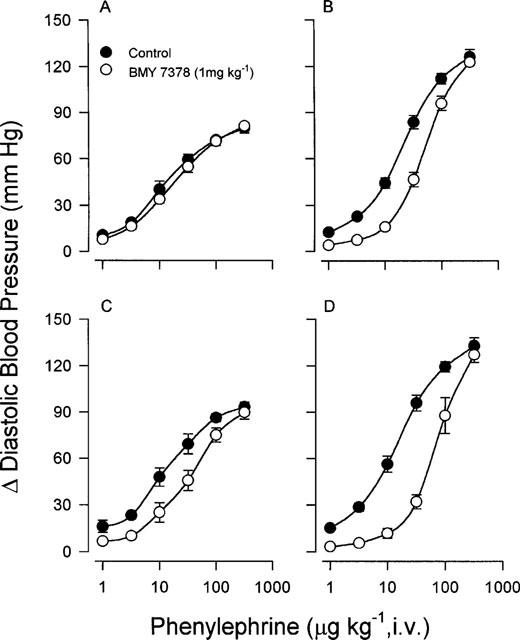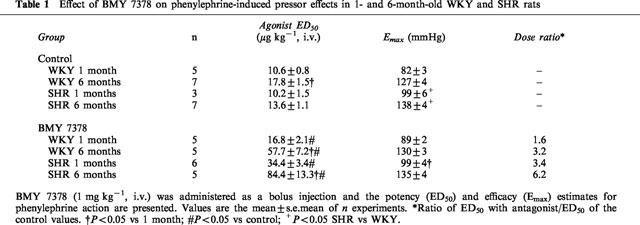Abstract
The role of α1D-adrenoceptors in the vasculature of spontaneously hypertensive (SHR) and normotensive Wistar Kyoto rats (WKY), of different ages was assessed in pithed rats by the use of the selective α1D-adrenoceptor antagonist BMY 7378 (8-[2-[4-(2-methoxyphenyl)-1-piperazinyl]-ethyl]-8-azaspiro [4.5]decane-7,9-dione dihydrochloride). BMY 7378 displaced the pressor effect of phenylephrine in young pre-hypertensive pithed SHR rats, but produced no effect in young WKY rats (dose ratio of 3.4 and 1.6, respectively), while in adult rats BMY 7378 produced a greater shift in the phenylephrine response curve than in younger animals (dose ratio of 3.2 and 6.2 in WKY and SHR, respectively). The presence of α1D-adrenoceptors in the vasculature of pre-hypertensive rats, suggests its role in the pathogenesis/maintenance of increased blood pressure.
Keywords: α1D-adrenoceptors, BMY 7378, pithed spontaneously hypertensive rats, ageing
Introduction
α1-Adrenoceptors are involved in smooth muscle contraction and rat aorta seems to be a prototypic tissue for the expression of the α1D-subtype (Hieble et al., 1995). It has been reported that vascular α1D-adrenoceptors play a role in pressor responses in vivo (Zhou & Vargas, 1996). Vascular contractile responsiveness seems to increase with ageing and this effect may be related to the marked increase in the maximal pressor effect of alpha-1-adrenoceptor stimulation observed in adult pithed rats (Ibarra et al., 1997). In addition, α1D-adrenoceptors are the predominant subtype that mediates contraction in aorta, carotid and mesenteric arteries of spontaneously hypertensive rats (SHR) (Villalobos-Molina & Ibarra, 1996). These data suggest that this receptor subtype may be related to the pathogenesis/maintenance of hypertension (Ibarra et al., 1998). However, despite the presence of the α1D-adrenoceptor mRNA in many rat tissues the protein is not detectable at the membrane level (Yang et al., 1997). This has generated doubts on the functional role of this receptor subtype. However, membranes from rat aorta show an abundant number of this receptor (Deng et al., 1996), and its functional role has been evidenced in several arteries with the use of antisense oligonucleotides (Piascik et al., 1997). These data suggest that its predominant role is at the vascular level. In an attempt to correlate vascular α1D-adrenoceptors with increase in blood pressure during ageing, we measured the pressor response to phenylephrine in BMY 7378, (8-[2-[4-(2-methoxyphenyl)-1-piperazinyl]-ethyl]-8-azaspiro [4.5]decane-7,9-dione dihydrochloride)-treated, pithed young and adult WKY and SHR rats.
Methods
Male WKY and SHR rats of 1 and 6 months of age (n=43) were used. All procedures were approved by the Institutional Animal Care and Use Committee. Basal diastolic blood pressure in anaesthetized rats (sodium pentobarbital, 35 mg kg−1, i.p.), were: 93±2 and 100±3 mmHg in 1 month-old WKY and SHR, respectively; while values were: 101±10 and 120±3 mmHg in 6 months-old WKY and SHR, respectively (P=0.05). Trachea were cannulated, the animals were pithed and were artificially respired with a Harvard pump (56 cycles min−1; volume: 20 ml kg−1). The vagi were then cut. Catheters were placed in the right femoral vein for drug injection and in the left carotid artery for recording of diastolic blood pressure and heart rate; the cannula placed in the carotid artery was connected to a TXD-300 pressure transducer (Digi-Med, Lexington, KY, U.S.A.).
Diastolic blood pressure was recorded by a BPA-190b blood pressure analyzer (Digi-Med), while the animals were maintained at 37°C.
Once the animals had stabilized for at least 15 min, basal diastolic blood pressure was determined. After collection of this data, rats from both strains and ages received either physiological saline (1 ml kg−1) or BMY 7378 (1 mg kg−1); 15 min later, dose-response curves for phenylephrine (1–1000 μg kg−1; spaced by a factor of 101/2), were constructed. Only one agonist dose-response curve was obtained per rat; in all cases, the maximal doses that could be tolerated by the animals were used. All drugs were purchased from Research Biochemicals Int. (Natick, MA, U.S.A.) and were dissolved in physiological saline. Fresh solutions were prepared for each experiment and the doses refer to the free base of substances.
Results are expressed as means±s.e.mean. Peak changes in diastolic blood pressure evoked by phenylephrine in saline- and antagonist-treated rats of 1- and 6-months of age were determined, and compared using Newman-Keuls' test, once an analysis of variance (randomized block design) had revealed that the samples represented different populations. Where appropriate, the Students' t-test was used. ED50 values were obtained by non-linear regression. A P value of 0.05 or less was considered statistically significant.
Results
Basal values of diastolic blood pressure in WKY of 1- and 6 month-old pithed rats (n=22 total) were, 36.0±1.2 and 30.1±1.3 mmHg; while those of SHR (n=21 total) were, 36.6±1.2 and 33.7±2.1 mmHg. These values remained unmodified 15 min after injection of either saline or BMY 7378.
The intravenous (i.v.) administration of phenylephrine evoked a dose-dependent increase in diastolic blood pressure, irrespective of age and strain (Figure 1). Phenylephrine evoked a higher maximal pressor effect in young and adult SHR compared to WKY (Table 1). While BMY 7378 only slightly modified phenylephrine action in young WKY rats (Figure 1A; Table 1), significantly shifted to the right the agonist effect in young SHR rats (Figure 1C, Table 1). In contrast, BMY 7378 significantly displaced phenylephrine ED50 in both adult WKY and SHR rats (Figure 1B and D; Table 1).
Figure 1.

Antagonist action of BMY 7378 in the pressor response to phenylephrine in WKY and SHR rats of different age. Pithed rats of 1 and 6 months of age were subjected to increasing i.v. doses of phenylephrine. (A) WKY, 1 month; (B) WKY, 6 months; (C) SHR, 1 month; (D) SHR, 6 months. Points represent the mean±s.e.mean of 3–7 rats.
Table 1.
Effect of BMY 7378 on phenylephrine-induced pressor effects in 1- and 6-month-old WKY and SHR rats

Discussion
Our data demonstrate the presence of α1D-adrenoceptors in the vasculature of young, pre-hypertensive SHR rats and its age-related appearance in adult WKY rats; a similar result has been observed with the ageing of the normotensive rat (Ibarra et al., 1997). The abundance of this receptor occurring in aorta follows this order SHR>WKY >>Wistar at mRNA, receptor number and functional levels (Stassen et al., 1997; Xu et al., 1998; Ibarra et al., 1998). The presence of α1D-adrenoceptors in the resistance vasculature of pre-hypertensive and hypertensive rats, may indicate that this receptor is involved in the pathogenesis/maintenance of high blood pressure in SHR. Moreover, the maximal pressor effect of phenylephrine was higher in SHR than in WKY rats, suggesting that occurrence of α1D-adrenoceptors could be involved in vascular hyperreactivity.
The facts that BMY 738 blocked α1D-adrenoceptors in isolated arteries of SHR rats (Villalobos-Molina & Ibarra, 1996), and that antisense oligonucleotides decreased aorta contraction to phenylephrine from normotensive rats (Piascik et al., 1997), also suggest that this receptor has a major role in the control of vascular function.
Taken together, evidence reported here as well as from the literature points to a possible role of α1D-adrenoceptors in the pathogenesis and/or maintenance of hypertension in SHR rats. Promising areas for future research include the knockout of the α1D-subtype gene in both normotensive and hypertensive animals, the use of antisense oligonucleotides against this subtype as well as the design of new, highly selective α1D-adrenoceptor antagonists with therapeutic potential.
Acknowledgments
Authors are indebted to Dr J.A. García-Sáinz for careful review of the manuscript. This work was supported in part by Grant No. 28553-M from CONACYT.
Abbreviations
- WKY
Wistar Kyoto rats
- SHR
spontaneously hypertensive rats
- BMY 7378
(8-[2-[4-(2-methoxyphenyl)-1-piperazinyl]-ethyl]-8-azaspiro [4.5]decane-7,9-dione dihydrochloride)
References
- DENG X.F., CHEMTOB S., VARMA D.R. Characterization of α1-adrenoceptor subtype in rat myocardium, aorta and other tissues. Br. J. Pharmacol. 1996;119:269–276. doi: 10.1111/j.1476-5381.1996.tb15981.x. [DOI] [PMC free article] [PubMed] [Google Scholar]
- HIEBLE J.P., BYLUND D.B., CLARK D.E., EIKENBURG D.C., LANGER S.Z., LEFKOWITZ R.J., MINNEMAN K.P., RUFFOLO R.R., JR International Union of Pharmacology X. Recommendation for nomenclature of α1-adrenoceptors: consensus update. Pharmacol. Rev. 1995;47:267–270. [PubMed] [Google Scholar]
- IBARRA M., LÓPEZ-GUERRERO J.J., VILLALOBOS-MOLINA R. Further evidence for the predominance of α1D-adrenoceptors in arteries of normotensive and spontaneously hypertensive rats. Pharmacol. Rev. Comm. 1998;10:135–142. [Google Scholar]
- IBARRA M., TERRÓN J.A., LÓPEZ-GUERRERO J.J., VILLALOBOS-MOLINA R. Evidence for an age-dependent functional expression of α1D-adrenoceptors in the rat vasculature. Eur. J. Pharmacol. 1997;322:221–224. doi: 10.1016/s0014-2999(97)00092-7. [DOI] [PubMed] [Google Scholar]
- PIASCIK M.T., HROMETZ S.L., EDELMANN S.E., GUARINO R.D., HADLEY R.W., BROWN R.D. Immunocytochemical localization of the alpha-1B adrenergic receptor and the contribution of this and other subtypes to vascular smooth muscle contraction: analysis with selective ligands and antisense oligonucleotides. J. Pharmacol. Expt. Ther. 1997;283:854–868. [PubMed] [Google Scholar]
- STASSEN F.R.M., WILLEMSEN M.J.J.M.F., JANSSEN G.M.J., DEMEY J.G.R. α1-Adrenoceptor subtypes in rat aorta and mesenteric small arteries are preserved during left ventricular dysfunction post-myocardial infarction. Cardiovasc. Res. 1997;33:706–713. doi: 10.1016/s0008-6363(96)00261-1. [DOI] [PubMed] [Google Scholar]
- VILLALOBOS-MOLINA R., IBARRA M. α1-Adrenoceptors mediating contraction in arteries of normotensive and spontaneously hypertensive rats are of the α1D or α1A subtypes. Eur. J. Pharmacol. 1996;298:257–263. doi: 10.1016/0014-2999(95)00781-4. [DOI] [PubMed] [Google Scholar]
- XU K., LU Z., WEI H., ZHANG Y., HAN C. Alteration of α1-adrenoceptor subtypes in aortas of 12-month-old spontaneously hypertensive rats. Eur. J. Pharmacol. 1998;344:31–36. doi: 10.1016/s0014-2999(97)01559-8. [DOI] [PubMed] [Google Scholar]
- YANG M., VERFURTH F., BUSCHER R., MICHEL M.C. Is α1D-adrenoceptor protein detectable in rat tissues. Naunyn-Schmiedeberg's Arch. Pharmacol. 1997;355:438–446. doi: 10.1007/pl00004966. [DOI] [PubMed] [Google Scholar]
- ZHOU L., VARGAS H. Vascular α1D-adrenoceptors have a role in the pressure response to phenylephrine in the pithed rat. Eur. J. Pharmacol. 1996;305:173–176. doi: 10.1016/0014-2999(96)00229-4. [DOI] [PubMed] [Google Scholar]


